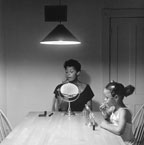
Read the review written for City newspaper in Rochester
here, or below:
Many modern women are hesitant to admit that they are feminists. The term typically requires clarification via a string of qualifiers, given the myriad negative cultural connotations and a history defined by divided opinion. Identifying as a feminist is even trickier for the feminist artist, who is already positioned outside a world often reserved for the male genius, resulting in further categorization and placement in a marginalized position. Carrie Mae Weems, an internationally renowned female, African-American photographer who often bitingly confronts issues of gender and race in her artwork, is no stranger to this concept. In fact, Weems uses the complications inherent in being a female artist as fuel for her work, flipping stereotypes and playing on viewers' assumptions in order to usurp them.
Currently on display at the University of Rochester's Hartnett Gallery, All About Eve is a cross-section of Weems' work from 1990 to 2006 that directly confronts gender issues. The exhibition's title evokes a dual meaning: the 1950 film of the same name and the biblical Eve. The artwork in the exhibition mirrors the title's multifaceted meaning as well, containing pieces that force viewers to explore several different female identity constructs --- the virgin and the whore, the mother and the daughter, the seducer and the seduced, the passive object and the aggressive subject.
Working with Hartnett Gallery director Derek Rushton, Weems selected 19 works from six distinct series and arranged them in a way that utilizes the gallery's idiosyncratic shape. Situated within Wilson Commons --- an oddly shaped building designed by architect I.M. Pei --- the triangular gallery provides a challenge to both artists and curators, but Weems and Rushton successfully use the space so that it actually enhances the work's strengths.
The left wall of the gallery, covered in a Weems-designed black-and-white wallpaper featuring a recurring female figure, contains a triptych from the series The Shape of Things (1993), and six photographs from the series Not Manet's Type (1997). The right wall is filled with five images from Weems' Kitchen Table (1990) series and three photographs from the series Framed by Modernism (1999).
The cleverest use of the gallery's space is where Weems has situated the piece The Apple of Adam's Eye (1995), a fabric folding screen that cuts across the acute corner connecting the gallery's left and right walls. The crimson partition employs a silk-screened image of a woman, shrouded in a royal blue sheet, and gold embroidered text to retell the biblical story of Adam and Eve. The front side of the panel reads "She'd always been the apple of Adam's Eye," but it is on the reverse side, which requires viewers to "trespass" into a tight corner, where Weems has left the rest of her humorous retelling: "Temptation my ass, desire has its place, and besides, they were both doomed from the start."

In the piece itself, Weems merges her talent as a visual artist and her acerbic humor. By selecting its unconventional gallery positioning, the poignancy is actually augmented. Forcing viewers to squeeze between the wall and the partition to view the back part of the screen is risky --- some patrons may be too timid to navigate the tight area and others will feel awkward as they work their way into the confined corner --- but it's necessary, as it heightens the themes of trespass and negotiation of space that are so common in Weems' artwork.
These themes are more prevalent in Weems' newest work, a short video titled Italian Dreams (2006), which plays on a loop on the gallery's back wall. Weems' eye for evocative visuals is readily apparent in this new video; it's an admirable addition to her already remarkable body of work. In the video, Weems (often the subject in her artwork) walks, with her back to the camera, through the hallways and gardens of Cinecittà, the studio in Rome made famous by Federico Fellini. Weems has admitted a love/hate relationship with Fellini's work due to his overt denigration of women, and here she consciously carves out a place for herself --- and women --- in that history.

This premise is apparent in several of the works on display. In the series Not Manet's Type, a woman (Weems again) shifts around a room in front of a mirror, the subject of both her own gaze and the viewer's. The text accompanying one panel states, "It was clear I was not Manet's type. Picasso --- who had a way with women --- only used me and Duchamp never even considered me."
All About Eve is a modest, but worthy exhibition of Weems' work. The skillfully nuanced pieces, seemingly disparate at first, are linked together by recurring themes, and their careful placement within the space-conscious gallery serves to reinforce their subtext. In her award-winning career, Weems has not only reclaimed historical settings for herself and women, but she has also proven herself a significant artist --- no qualifiers necessary.
All About Eve through March 9 Hartnett Gallery, Room 201, Wilson Commons, University of Rochester's River Campus Gallery hours: Monday-Friday, 11 a.m.-8 p.m.; Saturday-Sunday, noon-6 p.m.







